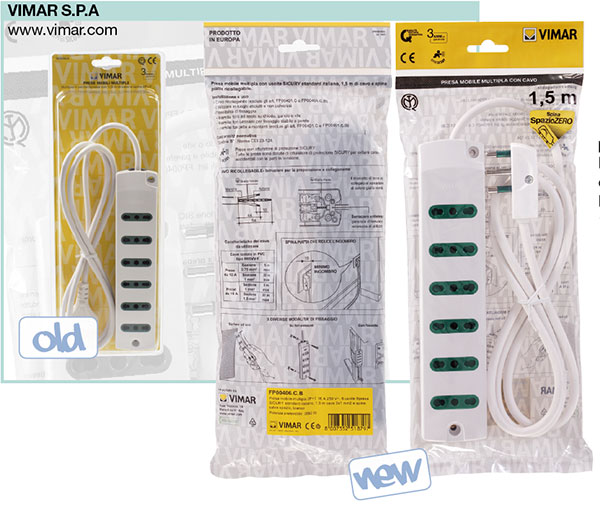The Italian Packaging Oscar 2016 An eco-technological design award
2016 is the year of the “best environmental packaging”. The event organized by the Istituto Italiano Imballaggio, this year in collaboration with CONAI, in fact offers stories of environmentally friendly packaging. With the winners on show at the Milan Design Week, the Oscar awards ceremony will be held April 15.
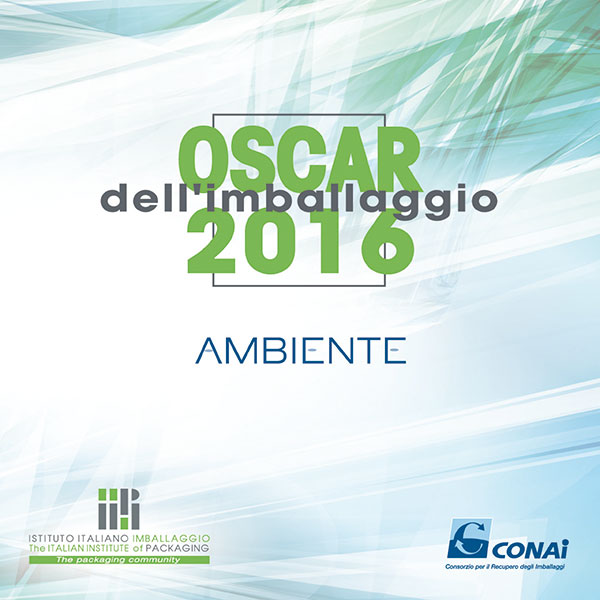
Stated in scientific terms, the environmental sustainability of packaging - lead thread for the Italian Packaging Oscar 2016, bears witness to the numerous actions of prevention adopted, like those promoted by Conai (reuse, saving of raw materials, use of recycled/reclaimed materials, facilitating recycling activities, logistics optimization, simplification of the packaging system, optimization of production processes).
The main new feature of the contest this year involves the way the candidates are chosen, this being via Conai’s Eco Tool, that assesses the packaging sustainability through a comparison gauging environmental impact of the packaging item “before and after” the changes made, this in terms of the reduction of CO2 emissions, energy and water consumption.
The projects on show must also respect the Ethical Packaging Charter, based on the principles of responsibility, balance, safety, accessibility, transparency, information, up-to-dateness, foresight, education and sustainability. Here too adherence to the guidelines is deemed decisive.
The contest is sponsored by Altroconsumo, the Milan Polytechnic Design School and Ipack-Ima.
A theme week Lastly, we cannot fail to emphasize the significance of the Italian Packaging Oscar as a key moment for promoting the image and content embodied by the Italian packaging world. On this count, for the third year running products and concepts will be on show during the Packaging Week, the international design get-together scheduled Milan April 12 to 17.
The location of Via Solferino 27 will hence host the 19 virtuous packaging items, cases of exemplary combination of function, innovation of materials, technologies and quality design. During the exhibition people will also be able to try their hand at the game “What packaging are you?”, thus acquiring greater awareness of our daily relationship with packaging according to one’s lifestyle. A series of open meetings between agencies and designers have also been scheduled: “Packaging design stories” will feature CBA Design and Paul Prossen Graphic & Design; insights in the field of eco design will instead be entrusted to Studio LCE, while the Warrant Group will address the theme “trademarks and patents”.
The Italian Packaging Oscar award ceremony will be held April 15, as part an event that will take place in the Buzzati hall at the Corriere della Sera newspaper HQ.
Below, the products in the competition: characteristics, advantages and innovation.
Acqua Minerale San Benedetto S.p.A - Angelini Acraf S.pA. - Barilla G&R F.LLi S.p.A - Cartonspecialist Srl - CLS - Cooperativa Lavoro e Solidarietà onlus - Colussi S.p.A - Davines Srl - Goglio S.p.A - Henkel Italia Srl - Lindt & Spruengli S.p.A - Lucaprint S.p.A - P.E.T Engineering Srl - Sammontana S.p.A - Sammontana S.p.A - Scatolifico Porrettana Srl - Sealed Air Srl - Smilesys Srl - Tubettificio M. Favia Srl - Vimar S.p.A
New 1 liter Easy, Progetto Ecogreen
San Benedetto’s 1 liter Easy format, part of the Progetto Ecogreen line, is dedicated to nature lovers and designed to contribute to the conservation of our planet’s resources.
Indeed, San Benedetto has reached a major research breakthrough with this solution: a bottle produced using 50% rPET (PET made from recycled plastic, reducing the use of virgin plastic and thus of petroleum), the maximum allowed by law.
The new Easy bottle has thus been made even more sustainable and functional for 2015 thanks to a further reduction in the use of PET in its production, as well as an innovative shape and a smart cap that is more lightweight than the standard caps that San Benedetto has used in the past.
Also worth mention is the fact that the Easy format is the first mineral water bottle format in Italy to be “carbon neutral”, with 100% of the greenhouse gas emissions caused by its life cycle offset by the concern’s purchase of “VER” credits to finance sustainable projects aimed at combating climate change.
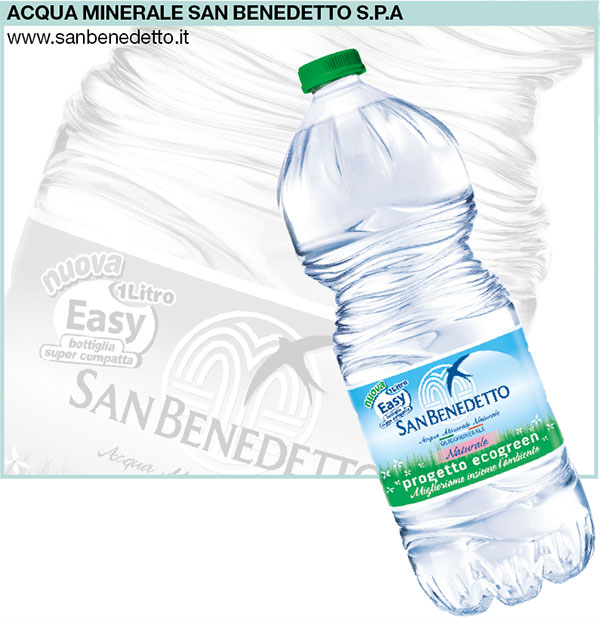

Multilingual information sheet to be read via QR code
It is estimated that about 60% of the more than 5 million foreign residents in Italy do not know Italian well. In addition there are about 50 million foreigners in transit every year in our country. In response to their needs, for all drugs based on ibuprofen and naproxen, Angelini has launched the multilingual leaflet, accessible via the QR code printed on the packaging: a great help for those who, because of linguistic difficulties, run the risk of incorrect assumption of self-medication.
The leaflet is available and printable in the 10 most widely spoken languages in the world: Mandarin Chinese, Arabic, Hindi-Urdu, Russian, Spanish, English, Portuguese, German, French and Italian.
To access them, simply open the application that enables reading of QR codes (usually already installed on all latest generation mobile phones) and frame the code with the camera to read the contents.
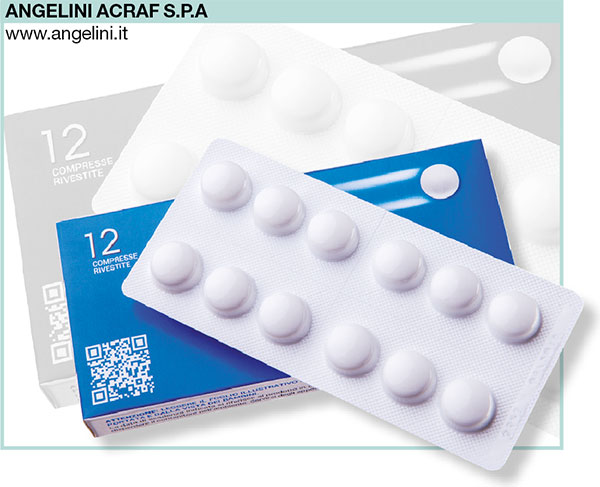

Pavesini: optimized packaging system
Reduce materials, optimize logistics, only place technically recyclable packaging on the market: these the sustainability objectives that have guided the Barilla Packaging Office while revising the Pavesini pack.
The most important change concerns the size of the primary and secondary packaging: the proportions of the tray in flat cardboard have in fact been changed, and the measure of the multipack film adjusted accordingly. In this way, the height of the corrugated cardboard case has also been reduced, increasing the capacity of each pallet by 14%. Corrugated cardboard consumption has thus been reduced by 10%, flat cartonboard by 5%. Overall 242 trucks per year have been taken off the Italian roads, saving 112 tons of paper material, without any impact on aspects of marketing, the product’s shelf image and final packaging cost.


Packaging line for BIOPAP® food
As ever engaged in the R&D of sustainable products (as well as energy optimization of its processes), Cartonspecialist has created the innovative performance and environmentally friendly BIOPAP® food packaging line. These recyclable, biodegradable and compostable containers (UNI EN 13432: 2002) can be disposed of as paper and/or with the moist organic fraction. They are also produced using virgin cellulose fibers, made from certified forests in Northern Europe managed according to sustainable development criteria.
The BIOPAP® containers are designed to withstand both low and high temperatures (from -40° to +215°) and can therefore be used both in the freezer and in the oven (conventional or microwave).
The areas of application are varied: catering for the transport of hot, cold and frozen meals with regeneration (cook & chill), frozen ready meals, fresh ready meals in modified atmosphere, fresh ready meals for the largescale retail fresh self-serve shelf or deli counter.
Under Comieco’s initiative the BIOPAP® “foodsaver” trays were distributed in various restaurants during EXPO 2015.
The BIOPAP® packaging is produced in Cartonspecialist establishments that consistently use solar energy and are in line with the Paris 2015 Framework Convention on Climate Change.
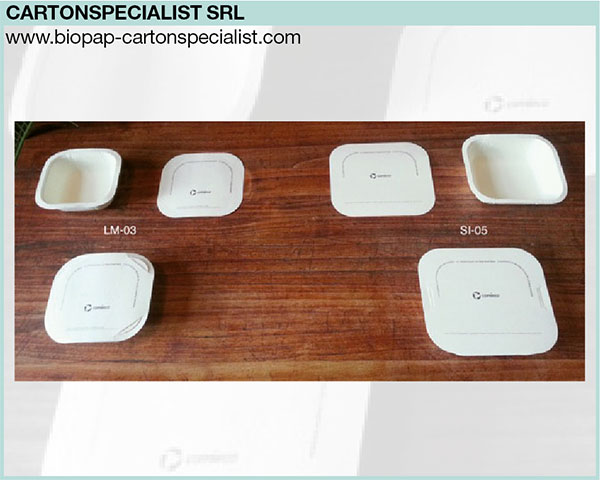

Packaging first, then prizes
Offering job opportunities to the disabled since 1983, Cooperativa Sociale e Solidarietà LA Onlus started out in contract assembly before growing over the years and eventually opening a boxworks of its own, and later a paper processing operation.
The latest achievement of the concern’s ongoing research in innovative CLS solutions is a patented pizza delivery box with a fun surprise: using high precision laser incision technology, the box has been decorated with removable 3D puzzle pieces that reproduce complex shapes (animals, monuments, etc.).
This unique process does not compromise the structure of the box or alter its foodsafe properties.
With this solution, Cooperativa achieves a twofold goal, since the system raises awareness about packaging recycling by offering an educational toy that gives value-added to the product. By assembling and coloring the puzzle, children learn and the product’s environmental impact is reduced.
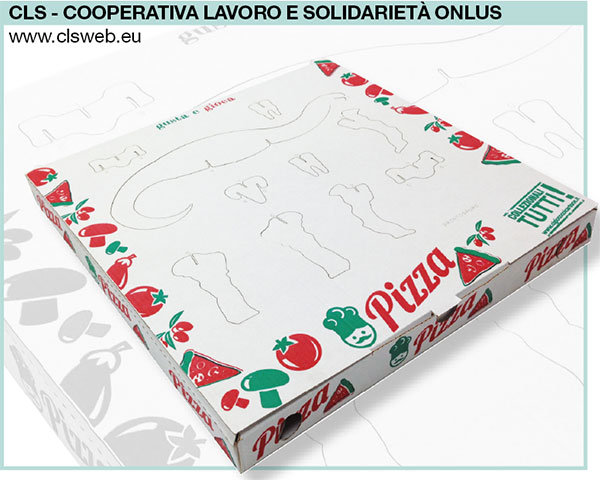

Light bag for Colussi biscuits
Always sensitive to the issue of environmental sustainability, Colussi is committed to delivering environmentally friendly packaging, with particular attention to aspects of recyclability, material savings and reducing emissions in the manufacturing process, all this in compliance with organoleptic and food safety standards.
By following these guidelines the packaging of Colussi biscuits has been overhauled, reducing the polypropylene by 25% while increasing the cellulosic component (14%): hence the packaging can now be disposed of in the segregated paper collection. In particular, the 3 layers (PP/CA/PP) that made up the previous packs have been reduced to 2
(PP/CA), thus decreasing the weight of each bag from 16 to 14 grams.
The change, which expressed in these terms may seem minimal, with large amounts leads to a significant reduction in environmental impact. In addition to the product presented in fact the intervention has also affects another 45 references with the same type of packaging and size (350 g), processed on the same line, for a total of 22.485 million packs sold in 2014.
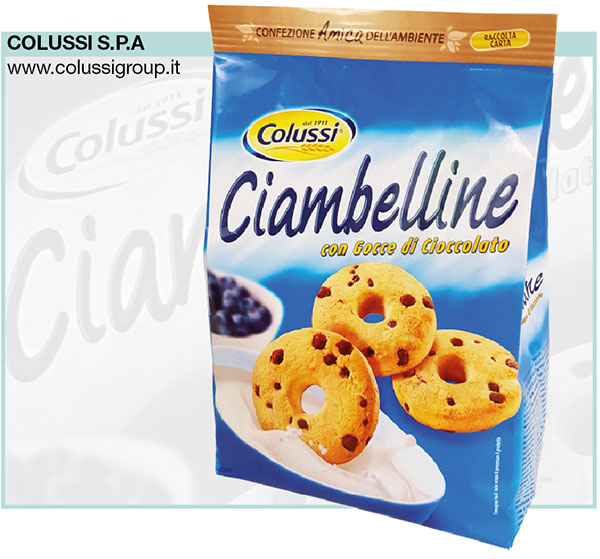

19 grams less plastic per bottle
In its R&D labs Davines creates professional products for haircare, formulated with focus on sustainability of the ingredients and ingeniously packed to minimize their environmental impact.
One of its flagship products, the Activator cosmetic hydrogen peroxide hair decolorer, requires containers perfectly compatible with its composition.
The Activator bottle is made of high density polyethylene, used in sizeable amounts to guarantee the stability of the bottle structure that, in 900 ml previous version previously weighed 75 grams (which, among other things, made it difficult to squeeze the bottle, impeding the smooth discharge of the product).
Thanks to the cooperation of the Davines laboratories with the manufacturer Tricobiotos and the packaging suppliers (Pibiplast for the bottle and CoPlast for the cap), in 2016 the first line of Activator bottles was launched made with 19 grams less plastic. The raw material saving on each item has led to a reduction in weight and volume, logistics optimisation and reduced CO2 emissions during transport. It has also enabled the internal volume of the container to be increased, making it smaller and less bulky.
The material reduction has not only made the bottle more economical and stable, but also more flexible and hence more functional for delivering the product.
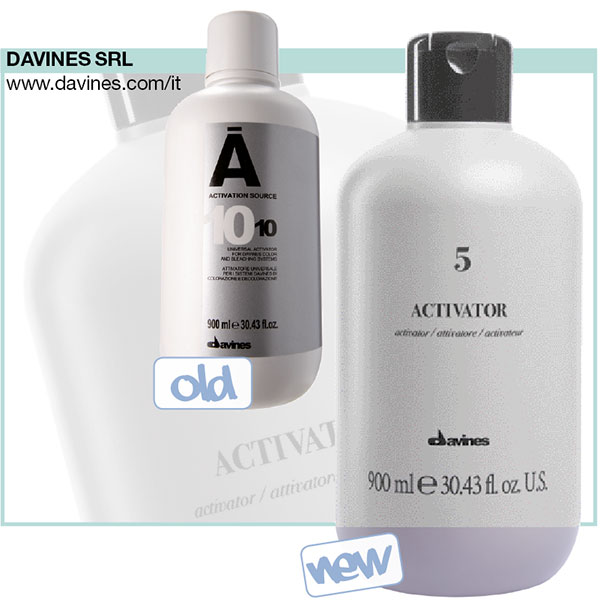

Stand-up bag...with integrated dispenser
Goglio presents “Fres-co Spready”, the new light, practical and functional “ready to spread” stand-up bag. For this packaging the Goglio R&D team has developed a double laminate with a simple but high performance structure: It is solely made of polyethylene film (without the traditional aluminum layer) which, thanks to the use of an innovative lacquering, guarantees the necessary oxygen protection barrier.
Fres-co Spready meets the various sustainability requirements. It is recyclable and reworkable in that it is derived from a single family of materials; furthermore the empty pack weighs about 50% less than those currently present on the market, guaranteeing a considerable raw materials savings, in addition to the usual advantages of flexible packaging: lower costs of storage, transportation and disposal after use.
Presented as a complete packaging, the solution integrates all value creating service functions without the need to apply accessory components: the holes are made directly in the material and protected by an easily removable film, enabling the dosing and sprinkling of the product without waste; the pouch, engraved and shaped at strategic points, can be safely and simply reclosed, even without a zip.


“Super €co Bottle” General & Nelsen
A process enabling the production of flacons using rPET is now in its second stage. Compared to the results achieved in 2013 (25% recycled PET, 41% of used plastic, 25% of material transported by volume), the concern has gone even further in 2015, reaching its target of 100% recycled PET for 3,000 ml format (exclusively for export) and 1,875 ml format for Italy, under the General €co brand (liquid laundry detergent) and the new Nelsen bargain format (liquid dish soap for handwashing).
The numbers on the concern’s replacement of virgin PET with 100% recycled PET show how effective the initiative has been.
- For the 1,875 ml format (a total of 9 million flacons produced in 2015), 347,000 kg of virgin plastic was replaced wtih 100% recycled plastic.
For the 4 million flacons produced for the Italian market, 154,400 kg of 100% rPET was used. The total volume of 100% rPET thus amounts to 463,000 kg, 206,000 kg of which just for the Italian market;
- For the 3000 ml format (a total of 1.1 million flacons produced in 2015, 66,000 kg of virgin plastic was replaced by 100% recycled plastic, or a total of 88,000 kg of 100% rPET.
Thanks in particular to the concern’s care in selecting the materials used, it was possible to maintain the same weight for each flacon, as well as technical performance, relative to production and filling.
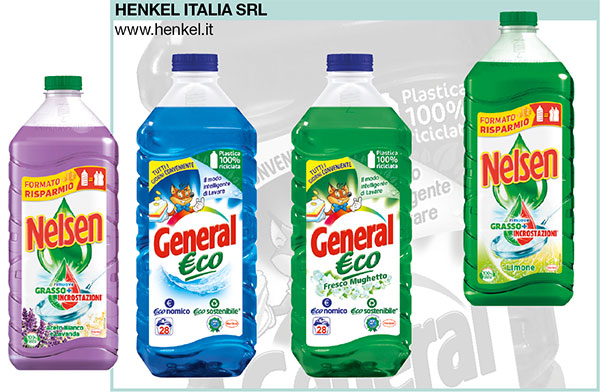

Reduced overpackaging for egg and prize
In line with its mission, which among other things includes respecting the environment throughout the entire supply chain, Lindt Italia presents a project for relaunching the Noccior egg, a flagship Easter product which the concern has redesigned in order to make it more sustainable.
The new concept reduces the product’s overpackaging, optimizes logistics and simplifies disposal by making it easier to recycle the packaging.
Both the packaging of the egg and that of the prize contained inside have been redesigned. In the latter case, a new flowpack made from laminated flexible material replaces the previous rigid polypropylene container with sealed laminated film for closure.
The new solution not only guarantees an excellent barrier against odors, protecting the chocolate from contamination, but also reduces the packaging’s weight by 97% (amounting to 107 tonnes less just in 2015, not counting the reduction in waste and saving on storage materials). The flowpack also enables enhancing the product’s communicative impact through tailored graphics reproducing the image of the Gold Bunny, the Lindt Easter brand logo.
The overpackaging has also been simplified, with fewer components: the egg’s plastic support has been eliminated. That element’s function is now performed by an interior protective thermoform, designed to use less raw material and simplify handling during packaging, improving productivity. These changes have enabled a significant reduction to the total weight of material used to pack each individual egg, the equivalent of 59% in the case of the 390 g format.
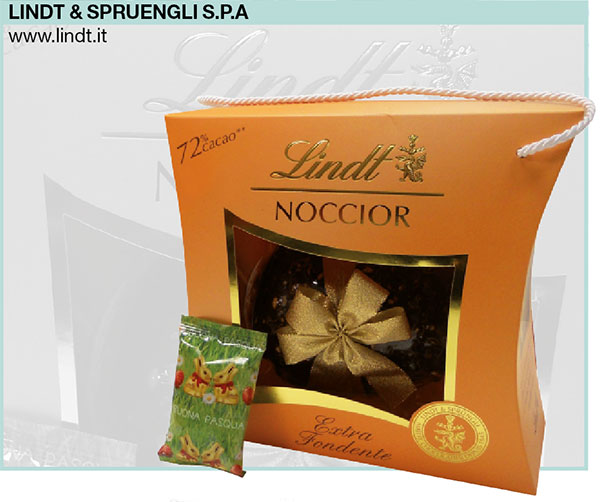

Packaging created from beans
The heightened sensitivity and reflections in recent years on the environment have led packaging concerns - and notably the paper industry - to review their processes in a sustainable way, especially as regards the use (and saving) of raw materials.
In this perspective an innovative sector project has been implemented by Lucaprint, which saw the involvement of Favini paper producers and the company Pedon SpA, leader in production and marketing of cereals, legumes and seeds.
The alliance has resulted in the design FSC certified and GMO-free food packaging, made from Favini Crush Fagiolo ecological cardboard, derived from legume processing waste not usable for human consumption provided by Pedon as a partial replacement of virgin cellulose pulp. The environmentally friendly inks and the transparent window in PLA, also obtained from plant waste, make the box - specially made for Pedon - eco-sustainable and 100% recyclable, as the following data show:
- 15% reduction of virgin cellulose from trees;
- use of 30% post-consumption recycled fiber;
- 20% reduction of greenhouse gases (e.g. CO2);
- use of 100% renewable energy for all production processes throughout the supply chain.
The partnership between companies with deep roots in the Vicenza area has hence demonstrated the considerable potential of supply chain integration, paving the way for a new approach in the recovery of processing waste in all sectors, not just food.
This approach is also a testament to how medium-sized enterprises that are heavily oriented toward sustainability can make a real contribution to promoting green sensitivity.


9.3. PET bottle for beer
Switching from glass to PET offers numerous advantages: unbreakability, safety during production, transport and consumption, lower weight and lower production and handling costs.
For these reasons, the P.E.T. Engineering team has developed 9.3, a 500 ml PET bottle for pasteurized beer – which is traditionally bottled exclusively with glass – which combines a premium look with high physical/mechanical performance.
The preform, specially designed and injection-moulded in house, guarantees optimal distribution of a monolayer material that is specially designed to prevent deformation even when subjected to the high temperatures of pasteurization (10 minutes or more at over 60 degrees Celsius). The solution’s high thermal stability is complemented by resistance up to 30 pasteurization units (PU).
Weighing just 26.3 g (instead of the approximately 270 g of the glass version), the distinctive, minimalist design of the 9.3 features a champagne bottom and a pull-off cap by Pelliconi, an excellent solution that is easy to implement for operators that wish to quickly transition from glass to PET on their existing bottling lines.
The HDPE label, PET body and HDPE/aluminium cap make it easy to recycle the entire solution without any separation necessary.
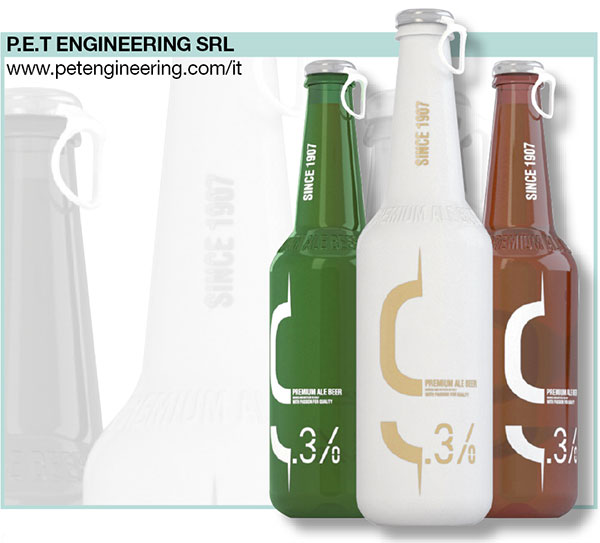

Gocce in Barattolino
Between 2014 and 2015, Sammontana made changes to the packaging of its “Gocce in Barattolino” product (vanilla ice cream bon bons coated with a thin layer of cocoa), entrusting to Piber Group Srl (Voghera, PV), the task of creating a new packaging solution (produced at its Piberplast facility).
Both the top and body of the new solution are injection-moulded.
The new top’s diameter is 80.6 mm; the external diameter of the tub is 84 mm, while that of the interior is 78 mm and the bottom is 60.7 mm. The new tub’s effective volume is 186 ml.
Thanks to structural changes to the body and closure, Sammontana has saved considerably on its use of polypropylene, thus meeting its target weight reduction to the primary packaging (as well as gains in sustainability, reducing total CO2 emissions needed to make the finished product).
The table below shows the pack’s weight reduction in detail:
Old New Weight
(g) (g) diff. (g)
Tub 12,9 10 -2,9
Closure 4,5 3,6 -0,9
Tot. primary pack. 17,4 13,6 -3,8
As the table illustrates, the new packaging saves 3.8 g of PP compared to the previous one, or 21.84% less plastic. This packaging optimization has also brought positive effects to the product’s logistics, moving from 1,080 units per crate to 1,122, and from 25,920 units per pallet to 28,050.
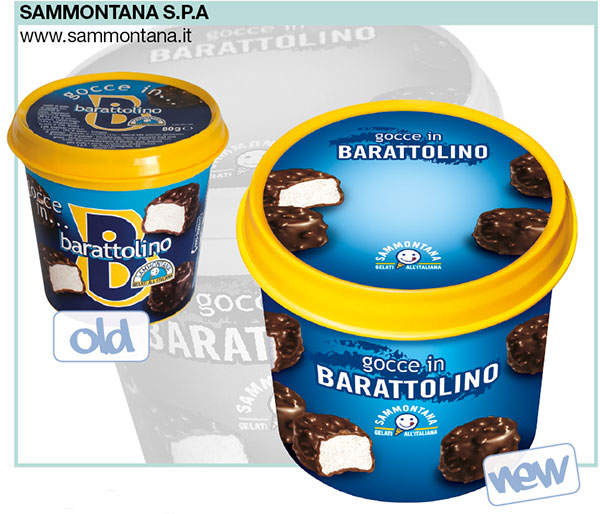

Megamix
Sammontana offers an ice cream tub that enables the end user to create their own mix by combining the ingredients each according to personal preference each time, making preparation an integral part of the consumer experience.
The tub features multiple compartments, one for vanilla ice cream, another for chocolate swirl and two different toppings (multicolor smarties and chocolate-covered cereal), making it an ideal product for families with children by letting them turn the moment of having ice cream into a one of sharing and fun, each creating their own unique ice cream dessert.
In order to create this packaging solution, Sammontana turned to Piber Group Srl (Voghera, PV), and in particular its Stamplast production unit. Established in 1990 in Pontecurone in a revamped historic ceramics factory, Stamplast has since developed knowhow and patents in the production of injection-moulded composite containers, with multilayer laminate injection and IMLs.
The closure and body of the Megamix tub are also injection-moulded, with the following dimensions: 181.44 mm (length) x 181.44 mm (width) x 63 mm (h) for the top; the internal dimensions of the tub are 166.4 mm x 166.4 mm x 63 mm (h); the external dimensions are 180 mm x 180 mm x 63 mm (h).
The tub’s brim-full volume is 1,090 ml.
The Megamix packaging’s division into four compartments represents an innovation in the retail ice cream sector.
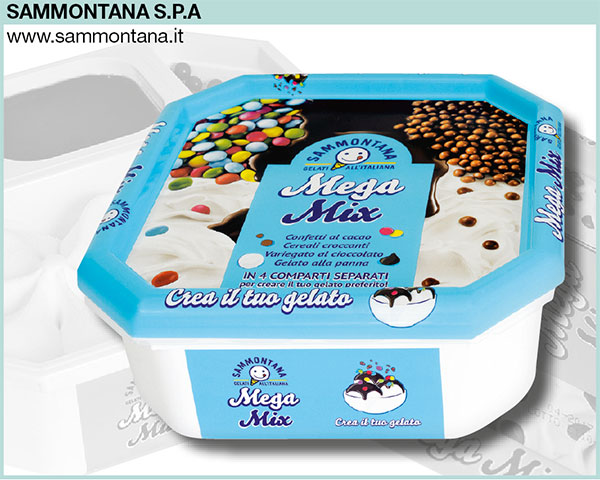

BanDiago: pallet and support in corrugated cardboard
Scatolificio Porrettana Srl (company certified UNI EN ISO 9001:2008) has been committed to a fifty year search for eco-friendly packaging and energy optimization of the production process. A path that has led to their patenting BanDiago: solution that takes full advantage of the characteristics of corrugated cardboard in an original way. In particular, used in the transport packaging of an ice cream making machine, it has enabled the elimination of the components in EPS and the wooden pallet, with consequent economic advantages. Thanks to the processing at 45° with ribs formed by folds and joins, without the use of glue or staples, the machine is completely protected and, in the event of a fall, the shock is absorbed before being transmitted to the contents.
The parameters for carrying out vibration tests (transport simulation) and 10 drop tests (on each of the 6 faces, 3 corners and 1 edge) are determined according to weight. The solution has been ISTA 1A certified, according to the regulations formally recognized worldwide by all shippers. In addition to its total recyclability, BanDiago presents other winning features: overall the packaging is very lightweight while maintaining a consistent loadbearing capacity (supporting up to 700 times its own weight); the reduction of raw material and optimization of volumes, the system having been designed for palletisation on pallets measuring 100x120, enable a reduction in transport costs, also decreasing the warehouse storage space requirements, since at the time of delivery the flat board only takes up 7 mm of thickness (90% less than the volume after assembly); lastly, when delivering abroad, BanDiago is not subject to the phytosanitary measures laid down for wood packaging.
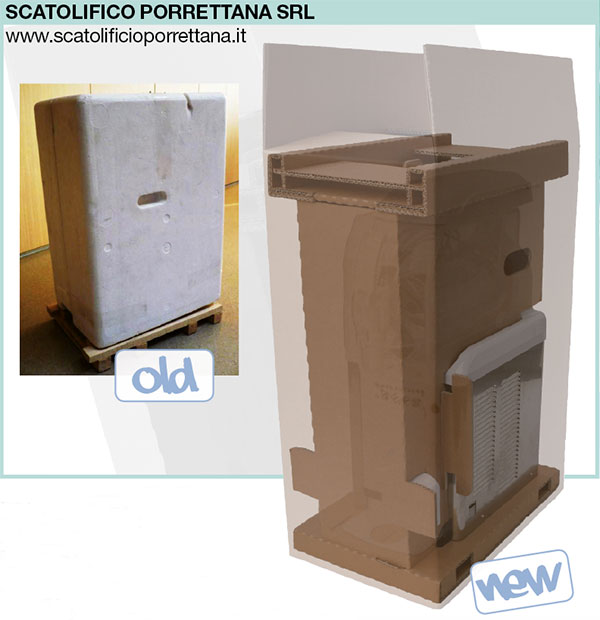

Cryovac® Sealappeal® line
According to a report by Essendra Packaging published in 2012, opening is the main source of consumer dissatisfaction with packaging solutions; 60% of consumers will go so far as to buy a different product after encountering difficulty with an opening Cryovac® Sealappeal® is a new addition to the range of packaging solutions developed by Sealed Air in order to resolve this issue. A peelable film that is easy to remove without breaking makes for uniform opening and poses no risk of bits of film ending up in the food product contained inside.
Sealappeal® PSF is a removable film (1) with a special sealant layer specially designed for fresh vegetable and fruit-based ready meals packed in trays. The film has no creases and features exceptional transparency, making the food look its best. Reduced thickness does not compromise the solution’s performance, and the firm seal prevents any contamination. Removing the film in one piece, with no tearing of the upper layer is guaranteed with all tray types and sealing methods.
Cryovac® Sealappeal® OSF – Ovenable Shrink Film (2) is designed for ready meals to be heated in a convection or microwave oven. In addition to excellent peelability and antifog properties, it guarantees easy cooking, enabling consumers to quickly prepare healthful, delicious meals.
Finally, the reduction of the overall weight of the materials used (APET/PE replacing PET) means less energy is used to produce the packaging and reduces disposal costs.
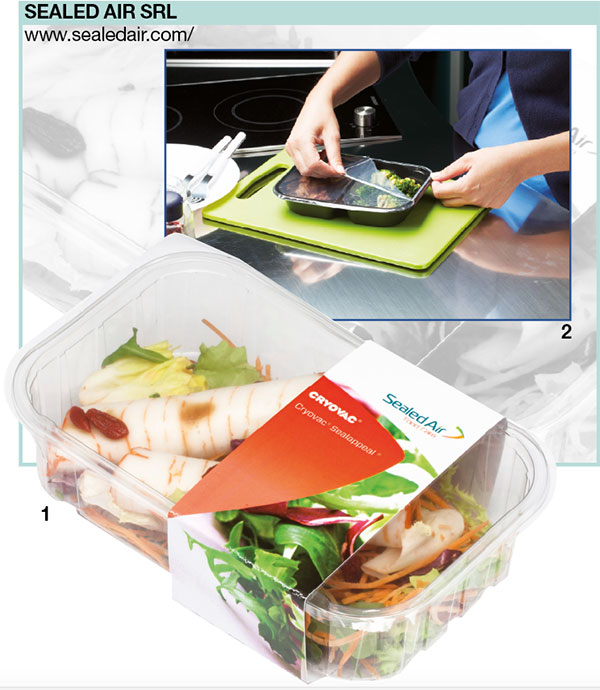

Smile Lite top for dried fruit
Three concerns combined their respective experience and knowhow to create the Smile Lite top: a new plastic reseal top for plastic tubs that is 100% recyclable since it is entirely made from PET. The system is made possible by exclusive patented Smilesys technology, which has been applied to film printed by Bioplast and used by Besana for a new product line. The advantage of this solution – which is available with various levels of barriers against gas and can be adapted to any thermoforming or preform tub top installations without additional equipment or setup – is that it guarantees maximum functionality and greater sustainability at the same time.
In fact, this new system enables considerable saving on plastic consumption (up to 7 times less than conventional lid closures), as well as a reduction to the packaging’s overall volume, which translates into less storage space needed in the warehouse and a drastic reduction in CO2 emissions and disposal costs.
Specifically, Smile Lite consists in two layers of polyester film that integrate easy peal and open & close functions in a single solution: the lower layer of the film remains sealed to the tub, acting as an internal border, and a special foodsafe adhesive guarantees reclosure dozens of times, preventing food waste due to the product spoiling after the packaging has been opened.
An end of closure block faciliates perfect repositioning of the film.
The lamination process has been designed to achieve maximum brilliance and transparency, guaranteeing the contents’ complete visibility without compromising the legibility of the instructions.
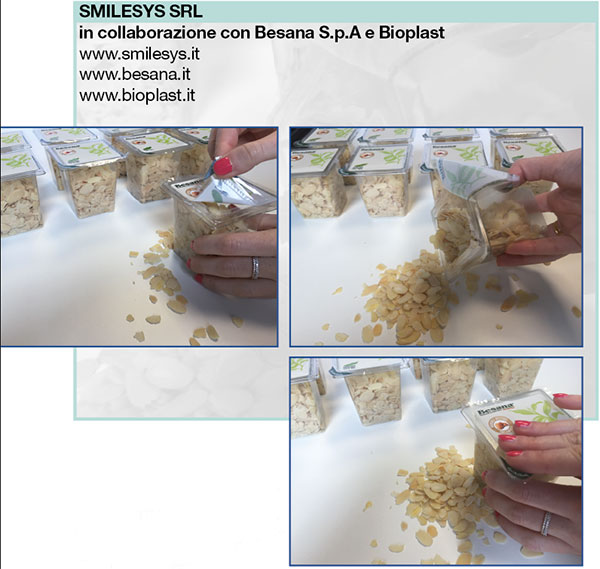

ToBeUnique: unlimited creativity for aluminium tubes
Although digital printing on aluminium tubes is a relatively recent phenomenon, Tubettificio Favia has pushed this innovation even further, implementing a one-of-a-kind system called ToBeUnique that enhances brand/product identity while protecting against counterfeiture.
ToBeUnique is a digital printing process for aluminium that, unlike conventional methods, is not limited to the body of the tube, but can also print the cap with no break in continuity, enabling unprecedented possibilities for graphic customization, enabling more effective communication of brand identity.
In addition to guaranteed excellence in color yield, digital printing represents an effective approach to anti-counterfeiture: indeed, when integrated with conventional offset printing, it makes it possible to achieve unique graphics that are impossible to replicate (further protecting consumers and their safety).
Finally, it guarantees excellent reproduction of the artwork supplied by the customer, perfectly adapting to the flexible tubes.
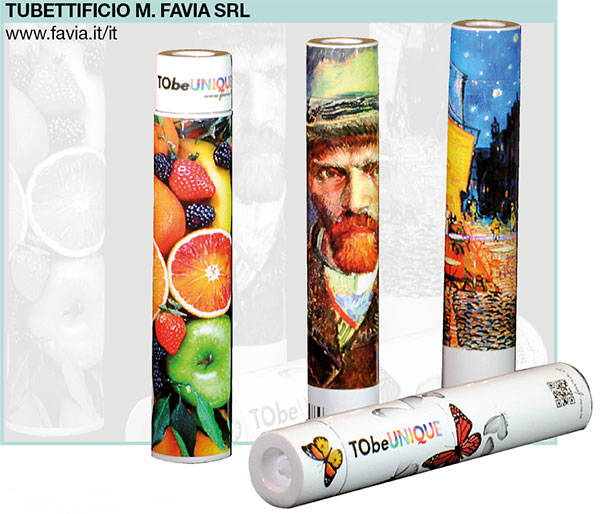

Space-saving lightweight PE packaging
In order to minimize the environmental impact of its new packaging for mobile charger splitters, Vimar has made a number of targeted adjustments: the primary packaging, which previously consisted in a blister with paperboard weighing a total of 55.5 g, is now a single polyethylene bag weighing just 7 g. The substantial saving in raw materials also enables a more efficient and simplified production process. The blister pack required special sealing equipment that had a packaging cycle speed of 65 pcs/hr. Now 111 bags can be packed in the same time thanks to a process that reqires just one step.
The secondary packaging has also been redesigned to enhance sustainbility. Whereas this component previously comprised 33% recycled paper, that proportion is now 70%.
The new packaging has also improved logistics: the significant reduction in volumes has enabled optimizing storage, jumping from 150 pieces per shelf to 800. More products per pallet means optimized loading for shipments.
